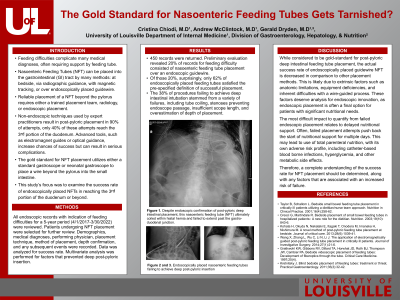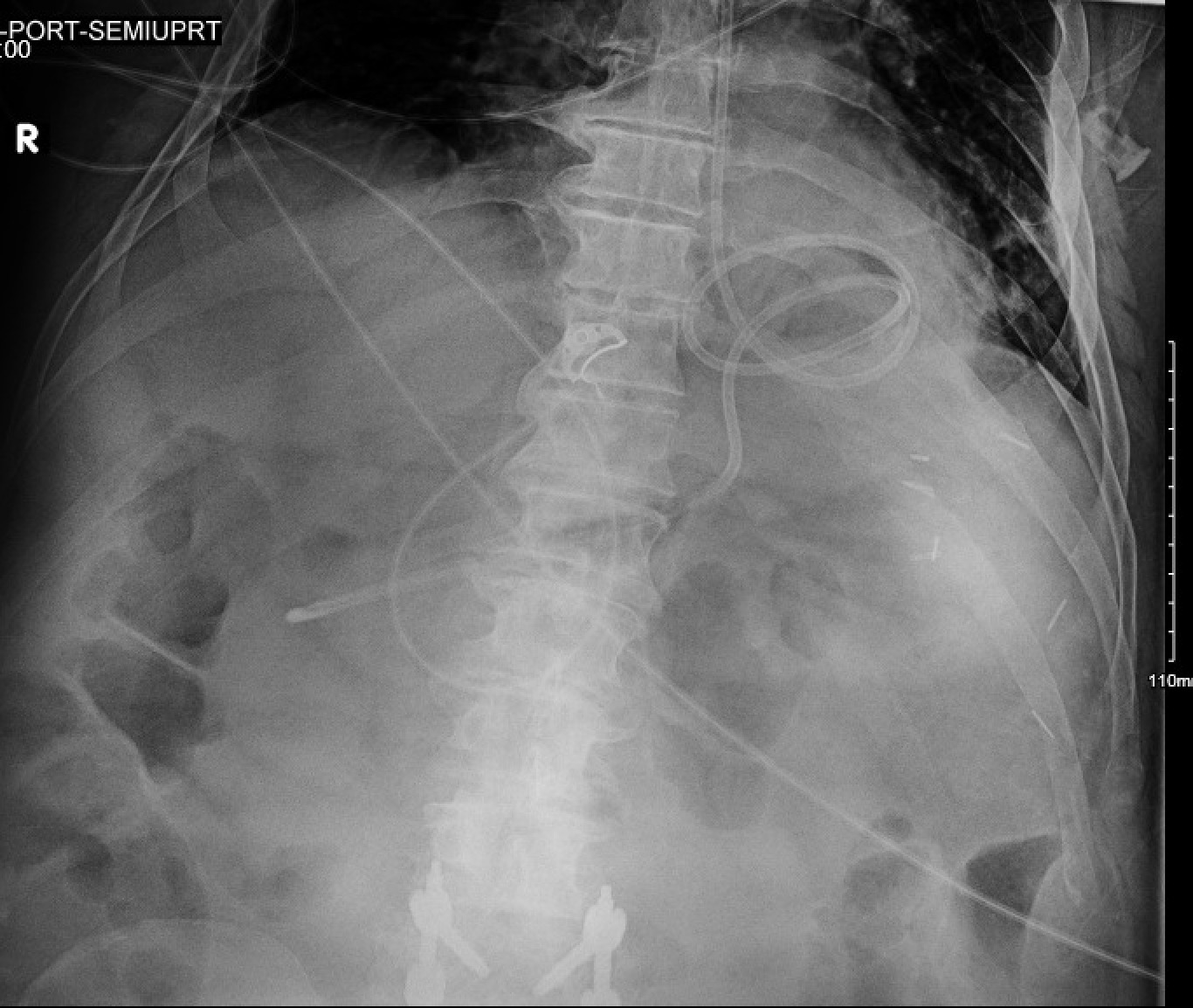Sunday Poster Session
Category: General Endoscopy
P0568 - The Gold Standard for Nasoenteric Tube Placement Gets Tarnished?
Sunday, October 22, 2023
3:30 PM - 7:00 PM PT
Location: Exhibit Hall

Has Audio
- GD
Gerald Dryden, MD, PhD, MSPH, MSc
University of Louisville
Louisville, KY
Presenting Author(s)
Cristina Chiodi, MD, Gerald Dryden, MD, PhD, MSPH, MSc, Andrew McClintock, MD
University of Louisville, Louisville, KY
Introduction: Feeding difficulties complicate many medical diagnoses, often requiring support by feeding tube (FT). Nasoenteric FT (NFT) can be placed into the gastrointestinal (GI) tract by many methods: at bedside, via radiographic guidance, with magnetic tracking, or over endoscopically placed guidewire. Reliable placement of a NFT beyond the pylorus requires either a trained placement team, radiology, or endoscopic placement. Non-endoscopic techniques used by expert practitioners result in post-pyloric placement in 90% of attempts, only 40% of these attempts reach the 3rd portion of the duodenum. Advanced tools, such as electromagnet guides or optical guidance, increase chances of success but can result in serious complications. The gold standard for NFT placement utilizes either a standard gastroscope or neonatal gastroscope to place a wire beyond the pylorus into the small intestine. In this study, we sought to examine the success rate of endoscopically placed NFTs in reaching the 3rd portion of the duodenum or beyond.
Methods: All endoscopic records with indication of feeding difficulties were reviewed. Patients undergoing NFT placement were selected for further review. Demographics, medical diagnoses, placement technique, method of placement, depth confirmation, and any subsequent events were recorded. Data was analyzed for success rate. Multivariate analysis was performed for factors that prevented deep post-pyloric insertion.
Results: 450 records were returned. Preliminary evaluation revealed 20% of records for feeding difficulty consisted of nasoenteric feeding tube placement over an endoscopic guidewire. Of those 20%, surprisingly, only 62% of endoscopically placed feeding tubes satisfied the pre-specified definition of successful placement. The 38% of procedures failing to achieve deep intestinal intubation stemmed from a variety of failures, including tube coiling, stenoses preventing endoscope passage, insufficient scope length, and overestimation of depth of placement.
Discussion: While considered to be gold-standard for post-pyloric deep intestinal feeding tube placement, the actual success rate of endoscopically placed guidewire NFT is decreased in comparison to other placement methods. This is likely due to extrinsic factors such as anatomic limitations, equipment deficiencies, and inherent difficulties with a wire-guided process. These factors deserve analysis for endoscopic innovation, as endoscopic placement is often a final option for patients with significant nutritional needs.

Disclosures:
Cristina Chiodi, MD, Gerald Dryden, MD, PhD, MSPH, MSc, Andrew McClintock, MD. P0568 - The Gold Standard for Nasoenteric Tube Placement Gets Tarnished?, ACG 2023 Annual Scientific Meeting Abstracts. Vancouver, BC, Canada: American College of Gastroenterology.
University of Louisville, Louisville, KY
Introduction: Feeding difficulties complicate many medical diagnoses, often requiring support by feeding tube (FT). Nasoenteric FT (NFT) can be placed into the gastrointestinal (GI) tract by many methods: at bedside, via radiographic guidance, with magnetic tracking, or over endoscopically placed guidewire. Reliable placement of a NFT beyond the pylorus requires either a trained placement team, radiology, or endoscopic placement. Non-endoscopic techniques used by expert practitioners result in post-pyloric placement in 90% of attempts, only 40% of these attempts reach the 3rd portion of the duodenum. Advanced tools, such as electromagnet guides or optical guidance, increase chances of success but can result in serious complications. The gold standard for NFT placement utilizes either a standard gastroscope or neonatal gastroscope to place a wire beyond the pylorus into the small intestine. In this study, we sought to examine the success rate of endoscopically placed NFTs in reaching the 3rd portion of the duodenum or beyond.
Methods: All endoscopic records with indication of feeding difficulties were reviewed. Patients undergoing NFT placement were selected for further review. Demographics, medical diagnoses, placement technique, method of placement, depth confirmation, and any subsequent events were recorded. Data was analyzed for success rate. Multivariate analysis was performed for factors that prevented deep post-pyloric insertion.
Results: 450 records were returned. Preliminary evaluation revealed 20% of records for feeding difficulty consisted of nasoenteric feeding tube placement over an endoscopic guidewire. Of those 20%, surprisingly, only 62% of endoscopically placed feeding tubes satisfied the pre-specified definition of successful placement. The 38% of procedures failing to achieve deep intestinal intubation stemmed from a variety of failures, including tube coiling, stenoses preventing endoscope passage, insufficient scope length, and overestimation of depth of placement.
Discussion: While considered to be gold-standard for post-pyloric deep intestinal feeding tube placement, the actual success rate of endoscopically placed guidewire NFT is decreased in comparison to other placement methods. This is likely due to extrinsic factors such as anatomic limitations, equipment deficiencies, and inherent difficulties with a wire-guided process. These factors deserve analysis for endoscopic innovation, as endoscopic placement is often a final option for patients with significant nutritional needs.

Figure: Despite endoscopic confirmation of post-pyloric deep intestinal placement, this nasoenteric feeding tube (NFT) ultimately coiled within hiatal hernia and failed to extend past the gastro-duodenal junction.
Disclosures:
Cristina Chiodi indicated no relevant financial relationships.
Gerald Dryden indicated no relevant financial relationships.
Andrew McClintock indicated no relevant financial relationships.
Cristina Chiodi, MD, Gerald Dryden, MD, PhD, MSPH, MSc, Andrew McClintock, MD. P0568 - The Gold Standard for Nasoenteric Tube Placement Gets Tarnished?, ACG 2023 Annual Scientific Meeting Abstracts. Vancouver, BC, Canada: American College of Gastroenterology.
